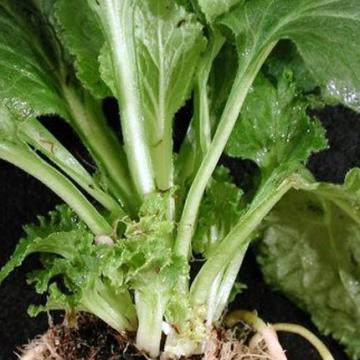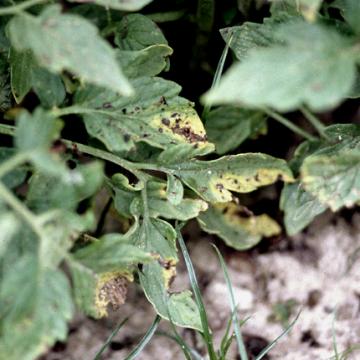DISEASE: Bacterial fasciation (Shoot proliferation)
HOST: Campanula
Overproduction of new shoots and short, thickened, distorted stems.

Bacterial fasciation (Shoot proliferation) | Campanula
DISEASE: Bacterial fasciation (Shoot proliferation)
HOST: Campanula (Campanula sp.)
PATHOGEN: Rhodococcus fascians
SOURCE: M. Putnam
DISEASE: Bacterial fasciation (Shoot proliferation)
HOST: Candytuft
The disease causes production of multiple shoots.

Bacterial fasciation (Shoot proliferation) | Candytuft
DISEASE: Bacterial fasciation (Shoot proliferation)
HOST: Candytuft (Iberis sp.)
PATHOGEN: Rhodococcus fascians
SOURCE: M. Putnam
DISEASE: Bacterial leaf spot (Bacterial necrosis)
HOST: Cassava
Cassava with yellowish leaves and water-soaked, angular spots. The disease is primarily on foliage, although the pathogen may invade stem buds and young branches.

Bacterial leaf spot (Bacterial necrosis) | Cassava
DISEASE: Bacterial leaf spot (Bacterial necrosis)
HOST: Cassava (Manihot esculenta)
PATHOGEN: Xanthomonas cassavae
PATHOGEN SYNONYM: Xanthomonas campestris pv. cassavae
SOURCE: APS
DISEASE: Bacterial leaf spot (Bacterial necrosis)
HOST: Cassava
Cassava with brownish lesions and blackish edges. Leaves turn yellow with multiple infection sites.

Bacterial leaf spot (Bacterial necrosis) | Cassava
DISEASE: Bacterial leaf spot (Bacterial necrosis)
HOST: Cassava (Manihot esculenta)
PATHOGEN: Xanthomonas cassavae
PATHOGEN SYNONYM: Xanthomonas campestris pv. cassavae
SOURCE: H. Maraite, A. Alvarez
DISEASE: Syringae leaf spot
HOST: Tomato
Leaves with brown necrotic lesions and chlorotic margins. Symptoms vary greatly among cultivars. Some have black or brown lesions with bright yellow, chlorotic areas and others do not have yellowing.

Syringae leaf spot | Tomato
DISEASE: Syringae leaf spot
HOST: Tomato (Lycopersicon esculentum)
PATHOGEN: Pseudomonas syringae pv. syringae
SOURCE: R. Gitaitis






